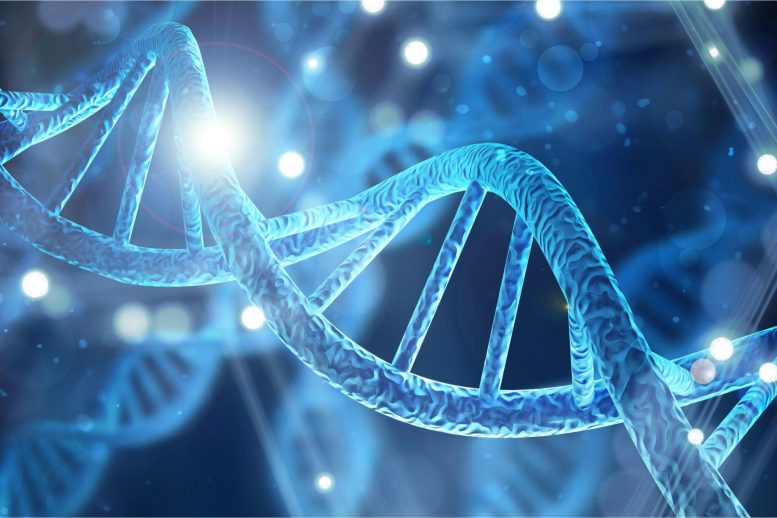
By utilizing ancient DNA, a team of researchers from various countries created a detailed genetic record of modern European lineages over time. The researchers were able to witness human DNA evolving in real-time and observe significant population changes that have occurred in Europe.
An international team of researchers used ancient DNA to reconstruct the first high-resolution genetic record of modern European lineages through time, observing both human DNA evolving in ‘real-time’ and the dramatic population changes that have taken place in Europe.
Ancient DNA recovered from a series of skeletons in central Germany up to 7500 years old has been used to reconstruct the first detailed genetic history of modern Europe.
The study, published today in Nature Communications, reveals a dramatic series of events including major migrations from both Western Europe and Eurasia, and signs of an unexplained genetic turnover about 4000-5000 years ago.
The research was performed at the University of Adelaide’s Australian Center for Ancient DNA (ACAD). Researchers used DNA extracted from bone and teeth samples from prehistoric human skeletons to sequence a group of maternal genetic lineages that are now carried by up to 45% of Europeans.
The international team also included the University of Mainz in Germany and the National Geographic Society’s Genographic Project.
“This is the first high-resolution genetic record of these lineages through time, and it is fascinating that we can directly observe both human DNA evolving in ‘real-time’, and the dramatic population changes that have taken place in Europe,” says joint lead author Dr. Wolfgang Haak of ACAD.
“We can follow over 4000 years of prehistory, from the earliest farmers through the early Bronze Age to modern times.”
“The record of this maternally inherited genetic group, called Haplogroup H, shows that the first farmers in Central Europe resulted from a wholesale cultural and genetic input via migration, beginning in Turkey and the Near East where farming originated and arriving in Germany around 7500 years ago,” says joint lead author Dr. Paul Brotherton, formerly at ACAD and now at the University of Huddersfield, UK.
ACAD Director Professor Alan Cooper says: “What is intriguing is that the genetic markers of this first pan-European culture, which was clearly very successful, were then suddenly replaced around 4500 years ago, and we don’t know why. Something major happened, and the hunt is now on to find out what that was.”
The team developed new advances in molecular biology to sequence entire mitochondrial genomes from the ancient skeletons. This is the first ancient population study using a large number of mitochondrial genomes.
“We have established that the genetic foundations for modern Europe were only established in the Mid-Neolithic, after this major genetic transition around 4000 years ago,” says Dr. Haak. “This genetic diversity was then modified further by a series of incoming and expanding cultures from Iberia and Eastern Europe through the Late Neolithic.”
“The expansion of the Bell Beaker culture (named after their pots) appears to have been a key event, emerging in Iberia around 2800 BC and arriving in Germany several centuries later,” says Dr. Brotherton. “This is a very interesting group as they have been linked to the expansion of Celtic languages along the Atlantic coast and into central Europe.”
“These well-dated ancient genetic sequences provide a unique opportunity to investigate the demographic history of Europe,” says Professor Cooper.
“We can not only estimate population sizes but also accurately determine the evolutionary rate of the sequences, providing a far more accurate timescale of significant events in recent human evolution.”
The team has been working closely on the genetic prehistory of Europeans for the past 7-8 years.
Professor Kurt Alt (University of Mainz) says: “This work shows the power of archaeology and ancient DNA working together to reconstruct human evolutionary history through time. We are currently expanding this approach to other transects across Europe.”
Genographic Project director Spencer Wells says: “Studies such as this on ancient remains serve as a valuable adjunct to the work we are doing with modern populations in the Genographic Project. While the DNA of people alive today can reveal the end result of their ancestors’ ancient movements, to really understand the dynamics of how modern genetic patterns were created we need to study ancient material as well.”
Reference: “Neolithic mitochondrial haplogroup H genomes and the genetic origins of Europeans” by Paul Brotherton, Wolfgang Haak, Jennifer Templeton, Guido Brandt, Julien Soubrier, Christina Jane Adler, Stephen M. Richards, Clio Der Sarkissian, Robert Ganslmeier, Susanne Friederich, Veit Dresely, Mannis van Oven, Rosalie Kenyon, Mark B. Van der Hoek, Jonas Korlach, Khai Luong, Simon Y.W. Ho, Lluis Quintana-Murci, Doron M. Behar, Harald Meller, Kurt W. Alt, Alan Cooper and The Genographic Consortium, 23 April 2013, Nature Communications.
DOI: 10.1038/ncomms2656









watch a movie thats almost banned from america called hidden colors.
IF an advanced culture experienced global disturbances that crashed their society and were forced to relocate and begin at a lower level with knowledge that allowed rapid advance, they would then have resolved problems that led to warfare especially in a sparsely settled world. You might even call it Eden.
Isolation would not have prepared them to confront violent incursions.